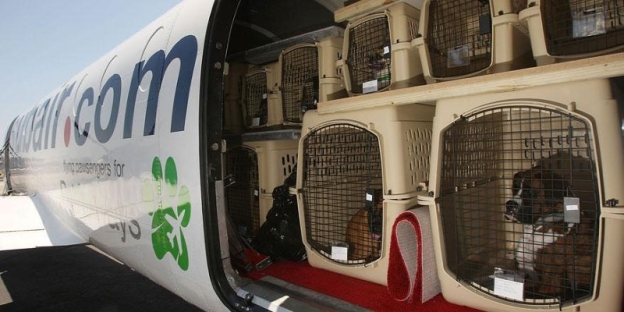Finance
Tracing the History of Employee Benefits: From Perks to Necessities
1758252980000
Planning international pet shipping can feel overwhelming. Is your pet flying in-cabin or cargo? What papers do you need? How do you prep them emotionally and physically? This guide walks through it all, from paperwork to pickup, to make the process less confusing and much more manageable.
Planning international pet shipping can feel overwhelming. Is your pet flying in-cabin or cargo? What papers do you need? How do you prep them emotionally and physically? This guide walks through it all, from paperwork to pickup, to make the process less confusing and much more manageable.
Before proceeding, you must verify the import rules of the destination country. Every place has its regulations, and not all of them are pet-friendly. For example, countries like Australia, New Zealand, and the UK are strict about quarantines and vaccinations. Others, such as Turkey or parts of Latin America, may have different forms or looser timelines, but still demand precision.

Start by visiting the official government site of the destination. Look for sections on pet import or animal quarantine. You'll often find a checklist. Most countries require:
Make sure your microchip is readable internationally. If your pet has an outdated chip, you may need a new one or bring your scanner. Rabies titers (antibody tests) may also be required, especially for pets travelling to the EU. These can take weeks to process, so don't leave them for the last minute.
Not all airlines allow pets on board, and those that do often limit options by breed or size. Brachycephalic (snub-nosed) dogs, such as pugs or bulldogs, are usually not allowed in cargo for safety reasons. Some carriers allow them in-cabin, but that depends on weight and size limits.
Airlines usually offer three modes:
Each comes with a different process, price, and paperwork. Cargo shipping, often used in international pet shipping, may involve working with a third-party pet relocation company. That adds cost but takes pressure off you. They usually handle permits, customs clearance, and local logistics.
Avoid routes with long layovers or extreme weather. Always fly direct where possible. Some airports don't have pet handling services, which can delay transfers and cause Stress for your animal.
Your pet’s crate isn’t just a container—it’s their world during the journey. It must meet IATA (International Air Transport Association) standards. These include rigid sides, ventilation on all four sides, leak-proof bottoms, and secure metal doors. No wheels allowed.
Measure your pet's standing, sitting, and lying-down heights. Add extra space for comfort. Inside the crate, you'll need:
Crate training ahead of time is non-negotiable. Let your pet sleep in it, eat treats there, and spend increasing amounts of time inside. This reduces panic during the actual trip.
Label the crate clearly with "LIVE ANIMAL" stickers, your contact info, and feeding instructions. Some airlines require an acclimation certificate stating that your pet can handle temperatures between 45°F and 85°F, so ask your veterinarian in advance.
Within 7–10 days of departure (exact timing depends on your destination), you'll need a final vet visit. The vet must inspect your pet, update vaccinations if necessary, and issue an official health certificate. This certificate typically requires endorsement from the national authority (such as the USDA in the US).
Carry both printed and digital versions of:
If you're working with a relocation service, they'll help coordinate all this. Otherwise, prepare for a few days of driving around, as some approvals require in-person visits, while others may experience mailing delays.
Don't underestimate the Stress that travel can cause for pets. Cramped spaces, strange smells, loud noises—it's a lot. Help ease this by adjusting routines two weeks before departure.
In the days leading up to the flight, act calm. Pets mirror your energy. If you’re frantic, they’ll sense it. Stay relaxed, speak in reassuring tones, and stick to familiar routines.
Once your pet lands, the collection process varies. If they travelled in-cabin, you can walk straight out. If they are checked baggage or cargo, they'll be held in a special area—often a separate terminal. Please bring your photo ID, the airway bill, and all original documents.

Customs may inspect your paperwork. If anything's missing or unclear, your pet may be held until the issue is resolved. Make sure your contact number is active and local. If you're not there to pick up, assign someone with a signed letter and a copy of your ID.
Some countries require a post-arrival vet check. This may happen at the airport or within 48 hours at an approved clinic. Always check ahead so you’re not scrambling in a new city.
While you can handle everything solo, hiring a pet relocation service can ease the load. These companies manage permits, bookings, customs, and even crate training.
For example, if you’re relocating from the US to Singapore—a country with strict pet entry rules—a good relocation service can guide you through quarantine bookings, pre-export approvals, and airport handling. They’re not cheap, but they do reduce the chances of mistakes that could delay your pet’s entry or result in extra fees.
This is especially helpful for routes involving layovers, breed restrictions, or temperature constraints. Some services even have vet teams and airport handlers who stay with your pet during transit.
Done well, international pet shipping becomes a structured journey, not a gamble. It begins with understanding local laws, continues with careful planning, and culminates in a joyful reunion. Keep the focus on your pet's comfort and compliance, and you'll both make it through just fine, ready for your new life together.
tech
1756805560000
education
1757585114000
tech
1757491038000
tech
1757406574000



